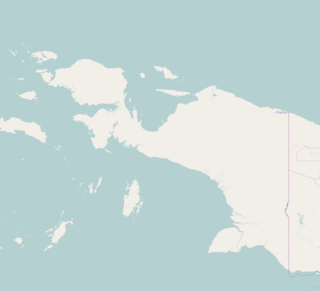Wutung (Udung) is a Skou language of Papua New Guinea. IT is spoken in the villages of Wutung and Sangke in Bewani-Wutung Onei Rural LLG of Sandaun Province. The two varieties are sometimes considered separate languages.
Wetarese is a language of Wetar, an island in the south Maluku, Indonesia, and of the nearby islands Liran and Atauro, the latter in East Timor north of Dili. The four principal varieties of Wetarese on Wetar are distinct enough they may be considered different languages.
Citak is the Papuan language of Citak-Mitak subdistrict (Kecamatan), Mappi Regency, Indonesia.

The Turama–Kikorian languages are a family identified by Arthur Capell (1962) and part of the Trans–New Guinea languages (TNG) family in the classifications of Stephen Wurm (1975) and Malcolm Ross (2005). The family is named after the Turama River and Kikori River of southern Papua New Guinea.

Ma'ya is an Austronesian language spoken in West Papua by 6,000 people. It is spoken in coastal villages on the islands Misool, Salawati, and Waigeo in the Raja Ampat islands. It is spoken on the boundary between Austronesian and Papuan languages. Both its tone and stress are lexically distinctive. That means both the stress and the pitch of a word may affect meaning. The stress and tone are quite independent from one another, in contrast to their occurrence in Swedish and Serbo-Croatian. It has three tonemes. Out of over a thousand Austronesian languages, there are only a dozen with lexical tone; in this case it appears to be a remnant of shift from Papuan languages. Ma'ya has five dialects, three on the island of Waigeo, one on Salawati, and one on Batanta. The prestige dialect is the one on Salawati. The Waigeo dialects have /s/ and /ʃ/, where the varieties spoken on Salawati and Misool have /t/ and /c/ respectively. Batanta, now extinct, was evidently unintelligible with its neighbours.

Ternate or Ternatese is a North Halmahera language of Indonesia. It is spoken on the island of Ternate, and some neighboring areas in North Maluku, including Halmahera, Hiri, Kayoa and the Bacan Islands. Historically, it served as the primary language of the Sultanate of Ternate, famous for its role in the spice trade.

Mpur, is a language isolate spoken in parts of the Bird's Head Peninsula of New Guinea. It is not closely related to any other language, and though Ross (2005) tentatively assigned it to the West Papuan languages, based on similarities in pronouns, Palmer (2018), Ethnologue, and Glottolog list it as a language isolate. Mpur has a complex tonal system with 4 lexical tones and an additional contour tone, a compound of two of the lexicals. Its tonal system is somewhat similar to the nearby Austronesian languages of Mor and Ma'ya.
Omati, or Mini, is a Papuan language of Papua New Guinea. The two varieties, Barikewa and Mouwase, are quite divergent.
Grand Valley Dani, or simply Dani, is one of the most populous Papuan languages in Indonesian New Guinea. The Dani people live in the Baliem Valley of the Western Highlands.
Yali is a Papuan language of Indonesian New Guinea. The Yali people live east of the Baliem Valley, in the Western Highlands.
One is a Torricelli dialect cluster of West Wapei Rural LLG in Sandaun Province, Papua New Guinea.
Yangum is a Torricelli dialect cluster of Papua New Guinea. Gel is nearly extinct. The principal variety is Mon, which is also known as Aiku, Malek, Menandon ~ Minendon; these names have been used for all Yangum varieties plus the closely related Ambrak.
Tabla is spoken on the coast of Tanahmerah Bay, close to Jayapura, in northern Papua (Indonesia). It is spoken in Bukia, Depapre, and Wari towns, and 13 villages on north coast.
Sowanda is a Papuan language of Sandaun Province, Papua New Guinea, with a couple hundred speakers in Indonesian Papua.
Gizrra, or Toga, is a Papuan language of New Guinea. Its two varieties are Western Gizrra and Waidoro.
MianiMa, is a Papuan language complex of Madang Province, Papua New Guinea. The northern and southern varieties are dialects in terms of vocabulary or pronunciation.
Womo and Sumararu are a Papuan language of Papua New Guinea. The two varieties are rather divergent.
Nambu is a Papuan dialect cluster of Papua New Guinea. Dialects are distinct but mutually intelligible. However, Ethnologue lists them as separate languages, because speakers prefer individualized literacy materials. Glottolog lists the following varieties: Nama and Dre, Namat, Nambo, Namo and Len, Neme and Nen.
Kimki (Aipki) or Sukubatom (Sukubatong) is an unclassified language of Batom Subdistrict, Pegunungan Bintang Regency, Papua, Indonesia. Ethnologue (2000) posited a connection with Biksi, but later abandoned it; Hammarström (2008) notes that there is insufficient data to connect Kimki with any other language, and it is not close to its neighbors. It is too poorly attested to be included even in such tentative classifications as Ross (2005), although Foley (2018) provides some data. Foley classifies Kimki as a language isolate, although he notes some similarities with Murkim.
Hoia Hoia (Hoyahoya) is a Papuan language of Papua New Guinea. It is close to Minanibai. The two varieties, Ukusi-Koparamio Hoia Hoia and Matakaia Hoia Hoia, are distinct languages, though significantly closer to each other than to other Inland Gulf languages. It is spoken in Ukusi-Koparamio village of Bamu Rural LLG in Western Province, Papua New Guinea.



